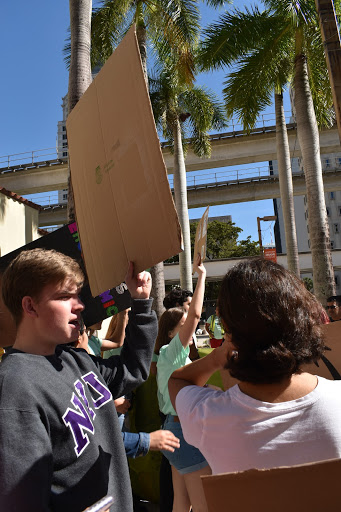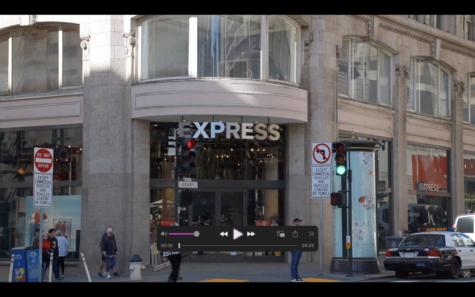Climate Change and Fashion

Photograph by G Bruce
Climate protestors are also concerned about how clothing and fashion can contribute to our environment.
On Friday, December 6th, South Florida youth joined fellow climate strikers on the streets of Downtown Miami. The sun relentlessly beat down and pedestrians watched as they chanted, “Our streets! Our city! Our planet! Our future!”

Co-State Leader of the Miami Climate Strike Gabi Marchesani
Gabriela Marchesani, the co-state lead of the Youth Climate Strike in Florida spoke to the importance of joining these strikes, saying that by doing so “we are [..] able to show our county, our county commissioners, our politicians that they aren’t going to get our votes unless they take climate action and actually take the climate crisis seriously.”
And take the climate crisis seriously they did. In October, the City of Miami Beach unanimously passed a resolution declaring that the city was under a climate emergency. The City of Miami followed suit in November. Marchesani hopes that this declaration will cause local politicians to “prioritize the climate crisis” and “work on it firsthand.” Now that local politicians have been made aware of their responsibilities, how else can young people passionate about their planet support the cause? The way to do this is through individual change. Marchesani adds, “I definitely, definitely think individual change is great. […] If you are able to make changes in your life, that is something you should definitely do.”Besides taking shorter showers and turning off the lights when exiting a room, there are many other ways to be a climate activist in everyday life, long after the megaphones stop booming through the streets and students are back in class. “Because it’s up to them [young people] to care about their future.”
One of the ways young people can live a more sustainable life is by avoiding the big businesses that target massive consumption from their young target markets- like fashion companies. “Fast-fashion” companies study and replicate street style and high fashion runways to satisfy the public’s desire to stay on-trend. Those most likely to fall prey to these companies’ designs are young people. Fast-fashion companies, such as Zara, Topshop and Forever 21, rather than release four new collections each year that coincide with the changing seasons, actually release collections that coincide with 52 “micro-seasons” each year. That’s one collection released each week. As a result, customers are manipulated to feel off-trend after a week of their purchase, so the cycle of buy, buy, buy ensues. These collections are designed to guarantee customer dissatisfaction that can only be satisfied by further purchase.
In order to keep up with trends, fast-fashion companies produce in such a rushed and urgent manner that they overlook the quality of their merchandise. The public is met with poorly-made pieces that are designed to be thrown away after a short period of time. Low quality is also met with lower costs, which eliminates the guilt of purchasing more. While you may be thinking, “what’s so wrong with low quality if I donate my clothes instead of throwing them away?” Of course, donating used and unwanted clothing may seem like a good idea, but the massive amounts of clothing donated each year are not met with a large enough demand in the U.S. According to Planet Aid, a nonprofit environmental organization, Americans discard 16 million tons of waste in the form of clothing each year, which equates to the weight of 400 cruise ships. Only 2 million tons of this total is actually donated. Despite the low cost at the end of the consumer, “fast fashion isn’t free. Someone, somewhere is paying,” as said by author and journalist Lucy Siegle. In this case, the cost of the merchandise is low but the price paid by underfed, underpaid, abused garment workers and the planet is unacceptably high. Not only do the unethical practices of fast-fashion companies directly jeopardize their workers, but they also affect the environment.
According to The Good Trade, a journalistic site that advocates for sustainable fashion, “brands like Forever21 use toxic chemicals, dangerous dyes, and synthetic fabrics” that eventually seep into and contaminate the water supplies of the foreign countries where production is held, as well as the water supplies of consumer countries when customers wash their clothes. When these toxic-chemical-ridden garments are thrown away, they continuously release maladies into the air since they almost never break down. Fast-fashion industries are rapidly climbing the ranks of largest carbon footprint, nearing air travel and oil.
This is where young climate activists step in and live to their “people over profit!” chant. In order to avoid fast-fashion companies, like Zara, Topshop, Forever 21 (to name only a few) and simultaneously defend against human rights violations and environmental crises, one must not only alter their consuming practices but also their values.
Although ethical, “slow-fashion” brands that, according to writer Audrey Stanton, move “towards mindful manufacturing, fair labor rights, natural materials, and lasting garments,”, may have price tags that appear daunting compared to their counterparts, the pros outweigh the cons. The reason why these prices are higher is because slow-fashion brands invest in their employees and take pride in the quality of their products. Moreover, the higher quality of these products means that consumers don’t need to buy, buy, buy because these products last years longer than those of fast-fashion brands.
Sustainable living in terms of fashion means investing in high-quality pieces that last for years rather than buying new clothes each season. A few slow-fashion brands, ranging in price, are Reformation, Everlane, Pact, thredUP and Alternate Apparel. Additionally, some larger name brands are becoming aware of their carbon footprint and acting upon it. For example, J.Crew and Madewell both announced partnerships with Fair Trade earlier this year, meaning that their pieces will be produced under standards that “promote sustainable livelihoods and safe working conditions, protection of the environment, and strong, transparent supply chains.”

Activists concerned about the planet are concerned about how many industries need to be more environmentally friendly.
Second-hand shopping also serves as a great alternative to fast-fashion. The increasing popularity of thrift shopping at stores such as Goodwill has been met with the establishment of numerous online second-hand shops, such as Depop, Etsy, Poshmark and Swap.com.
While the main culprit of climate change does prove to be the carbon emissions of big corporations, young adults in their everyday life can lead more sustainable lives by ensuring that the origins of the clothes on their backs can, too, make a difference..

Giulianna Bruce is a senior at MCDS and she’s so excited to be this year's Editor-in-Chief of The Spartacus! Giulianna joined three years ago with the...












Ana • Dec 29, 2019 at 8:48 pm
Great article Giulianna Bruce !!!